 To enhance service speed and avoid tariff delays, we've opened a US warehouse. All US orders ship directly from our US facility.
To enhance service speed and avoid tariff delays, we've opened a US warehouse. All US orders ship directly from our US facility.
| Cat. No. | Product Name | Field of Application | Chemical Structure |
|---|---|---|---|
| DC60619 | 12T-O14 |
12T-O14 is a amidine-incorporated degradable (AID) lipid for versatile mRNA delivery. 12T-O14-LNPs mediate efficient intramuscular delivery of mRNA vaccines and systemic delivery of mRNA therapeutics without noticeable toxicity. 12T-O14 serves as a superior supplementary lipid to redirect liver-tropic LNPs to selectively target the lung or spleen via simple adjustment of the formulation.
More description
|

|
| DC89031 | SM-102 IMPURITY 2 |
SM-102 N-oxide is potential impurity in commercial preparations of SM-102.
More description
|
.png)
|
| DC65619 | Lipid 11-A-M Featured |
LNP Lipid-8 (11-A-M) is an ionizable lipid, which can be used for lipid nanoparticles (LNP) to deliver siRNA to T cells without targeting to ligands. LNP LIPs-8 loaded with GFP siRNA (siGFP), and significantly causes GFP gene silencing in mice model.
More description
|

|
| DC67118 | PNI 132 Featured |
PNI 132, an ionizable lipid derived from the patent WO2020252589A developed by Precision Nanosystem, is useful in the formulation of lipid nanoparticles.
More description
|
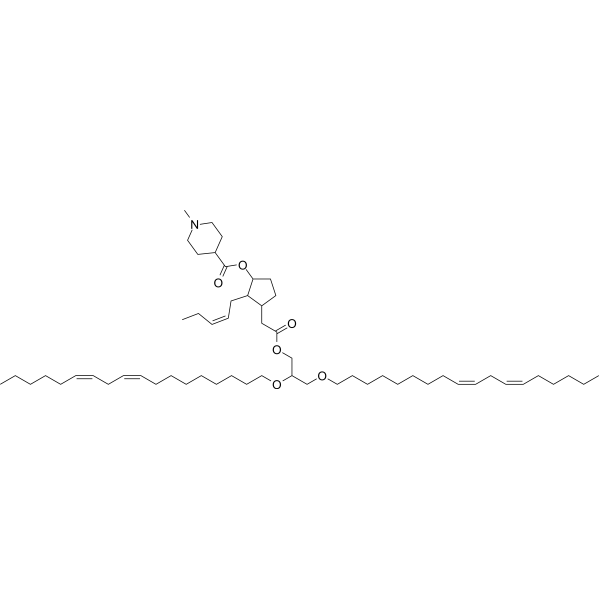
|
| DC60352 | DDAB |

|
|
| DC60213 | DOTMA Featured |
N-[1-(2,3-Dioleyloxy)propyl]-N,N,N-trimethylammonium (DOTMA) is a cationic lipid.It has been used as a component in liposomes that can be used to encapsulate siRNA, microRNAs, and oligonucleotides and for gene transfection in vitro.
More description
|

|
| DC33635 | DODAP Featured |
DODAP, also known as 1,2-Dioleoyl-3-dimethylammonium-propane, is a cationic lipid. It has been used as a component in liposomes that can be used to encapsulate siRNA, immunostimulatory oligodeoxynucleotides, antisense oligonucleotides, or chemotherapeutic agents for in vitro and in vivo delivery.
More description
|

|
| DC33636 | DOTAP Featured |
DOTAP, also known as 1,2-Dioleoyl-3-trimethylammoniumpropane, is a cationic liposome-forming compound used for transfection of DNA, RNA, and other negatively charged molecules into eukaryotic cells. It has been used in gene delivery vectors for gene ther
More description
|

|
| DC33580 | DODMA Featured |
DODMA, also known as MBN 305A is a a cationic lipid containing the unsaturated long-chain (18:1) oleic acid inserted at both the sn-1 and sn-2 positions. It has been used in the composition of lipospomes formulated as stable nucleic acid lipid particles that can encapsulate siRNA or other small molecules to be used for drug delivery
More description
|

|
| DC65362 | BP Lipid 114 Featured |
BP Lipid 114 is a well-designed ionizable lipid optimized for mRNA encapsulation and delivery. Its ethanolamine headgroup, ester bonds at the C6 and C8 positions, and 9-carbon tail contribute to efficient mRNA complexation, stability during delivery, and improved biodegradability. These properties make it a valuable component in LNPs for gene therapy and other mRNA-based therapeutic applications.
More description
|

|
| DC65390 | BP Lipid 135 Featured |
BP Lipid 135 is a well-designed ionizable lipid optimized for mRNA encapsulation and delivery. Its propanolamine headgroup, ester bonds at the C8 position, and 9-carbon tail contribute to efficient mRNA complexation, stability during delivery, and improved biodegradability. These properties make it a valuable component in LNPs for gene therapy and other mRNA-based therapeutic applications.
More description
|

|
| DC82301 | IC-8 Featured |
IC8 is an ionizable cationic lipid. It has been used in combination with other lipids for the formation of lipid nanoparticles (LNPs). Immunization with severe acute respiratory coronavirus 2 (SARS-CoV-2) spike glycoprotein mRNA in IC8- and manganese-containing LNPs induces IgG responses to SARS-CoV-2 Delta and Omicron variants in mice.1 Administration of mRNA encoding B7-H3 X CD3 bispecific T cell engaging (BiTE) antibodies in IC8-containing LNPs reduces tumor growth in MV4-11 and A375 mouse xenograft models.
More description
|

|
| DC80070 | A2-Iso5-2DC18 Featured |
A2-Iso5-2DC18 is a top-performing lipid for mRNA delivery in bone marrow-derived dendritic cells (BMDCs), BMDMs and HeLa cells.
More description
|

|
| DC86120 | LIPID 10 Featured |
Lipid 10 is a novel ionizable cationic lipid be used for delivery of therapeutic RNA to the Bone Marrow in Multiple Myeloma Using CD38-Targeted with Lipid 10-LNP.
More description
|

|
| DC60215 | Moderna Lipid 29 Featured |
Lipid 29 is an ionizable amino lipid (pKa = 6.91) from Moderna platform that has been used in combination with other lipids in the formation of lipid nanoparticles (LNPs).Administration of human erythropoietin (EPO) mRNA in lipid 29-containing LNPs increases serum EPO levels in mice.
More description
|

|
| DC60825 | 11-10-8 Featured |
11-10-8 is an ionizable cationic lipid (pKa = 6.22) that has been used in the generation of lipid nanoparticles (LNPs) for mRNA delivery in vivo.1 LNPs containing 11-10-8 and encapsulating mRNA encoding the Cas9 nuclease and small-guide RNA (sgRNA) targeting transthyretin (TTR), a thyroid hormone carrier protein, decrease serum levels of TTR in mice. LNPs containing 11-10-8 and encapsulating mRNA encoding human fibroblast growth factor 21 (hFGF21) increase serum levels of hFGF21, decrease body and liver weights, and reduce the liver steatosis score in a mouse model of obesity induced by a high-fat diet.
More description
|

|
| DC49908 | OF-02 Featured |
OF-02 (OF-2) is an alkenyl amino alcohol (AAA) ionizable lipid for highly potent in vivo mRNA delivery.Alkenyl amino alcohols (AAA) are a functional group found in sphingosine and other bioactive molecules. It was used to prepare
AAA-based ionizable lipids through ring-opening reactions between alkenyl epoxides (AEs) and polyamine cores. These
AAA-based iLNPs could promote high-level protein expression Therefore, AAA-based ionizable lipids OF-00, OF-01,
OF-02, and OF-03 were prepared. The results of in vivo delivery
of human erythropoietin (hEPO) mRNA showed that the AAA
ionizable lipid OF-02 with the linoleic acid derivative
could effectively deliver hEPO mRNA. Compared with the positive
control CKK-E12, OF-02 showed an increased ability to
induce serum EPO protein expression by nearly twofold
(Figure 7b). Likewise, it outperformed two benchmark ionizable
lipids (503013 and C12-200) in the nucleic acid delivery field.
Furthermore, the mRNA delivered by OF-02 iLNPs was mainly
in vivo.translated into the liver. The liver-targeting ability of OF-02 iLNPs
improves their delivery efficiency. Therefore, the OF-02 iLNPs
may become excellent delivery vehicles for the treatment of liver
diseases without other side effects of damage to other organs
during the treatment
More description
|
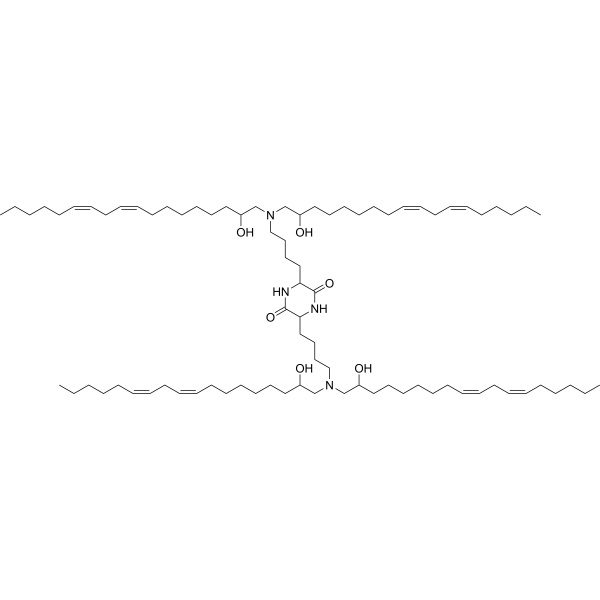
|
| DC60475 | CL4F8-6 Featured |
CL4F8-6 is an ionizable cationic lipid (pKa = 6.14) that has been used in combination with other lipids in the formation of lipid nanoparticles (LNPs).1 LNPs containing CL4F8-6 and encapsulating an mRNA reporter accumulate specifically in the mouse liver after intravenous administration. LNPs containing CL4F8-6 and encapsulating mRNA encoding the Cas9 nuclease (mCas9) and single-guide RNA (sgRNA) targeting Ttr (sgTtr), the gene encoding transthyretin, have been used to induce CRISPR-mediated gene knockdown in mice resulting in a reduction of serum levels of TTR.
More description
|
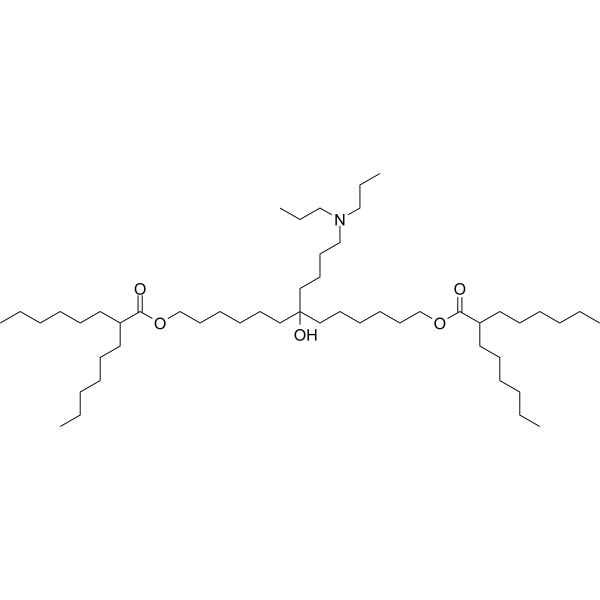
|
| DC65328 | AA-T3A-C12 Featured |
AA-T3A-C12 is an anisamide ligand-tethered lipidoid (AA-lipidoid) with high potency and selectivity to deliver RNA payloads to activated fibroblasts.
More description
|
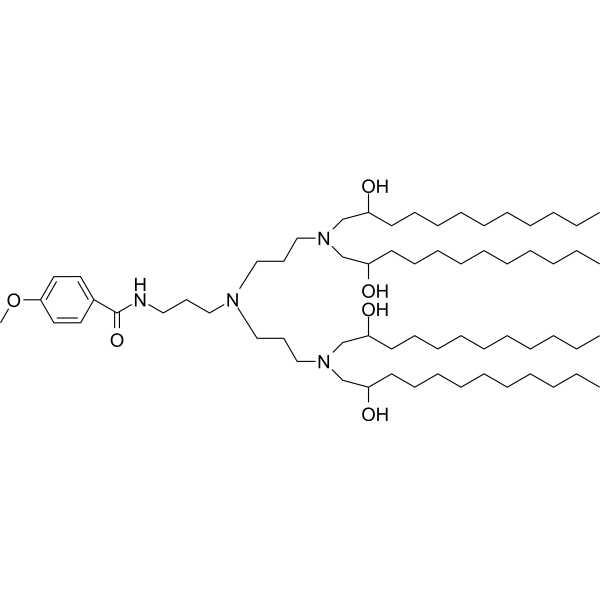
|
| DC49932 | FTT5 Featured |
FTT5 is a lipid-like compound for efficient delivery of long mRNAs in vivo.
More description
|

|
| DC70008 | CLinDMA |
CLinDMA, a cationic lipid known to potentially trigger inflammatory responses, is utilized in the synthesis of LNP201. This liposome-based assembly is specifically designed for the systemic delivery of siRNA.
More description
|

|
| DC49883 | L343 |
L-343 is an ionizable cationic lipidoid and can be used to synthetic liposomes for systemic delivery of RNAi therapeutics, Pka: 6.34.L343, with its sterically hindered tert-butyl esters, exhibited slower elimination from plasma and higher and more persistent levels in liver compared with L319.
More description
|
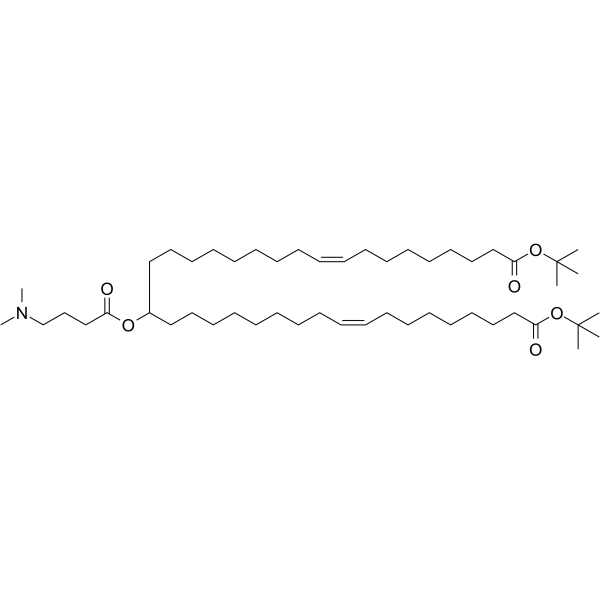
|
| DC71034 | EDMPC |
EDMPC, a cationic lipid, has an enhanced ability to deliver DNA to pulmonary tissues. EDMPC mediates intralobar DNA delivery to rodents.
More description
|

|
| DC70989 | 14:0 DAP |
14:0 DAP (1,2-dimyristoyl-3-dimethylammonium-propane ) is a cationic lipid that can be used for drug delivery.
More description
|
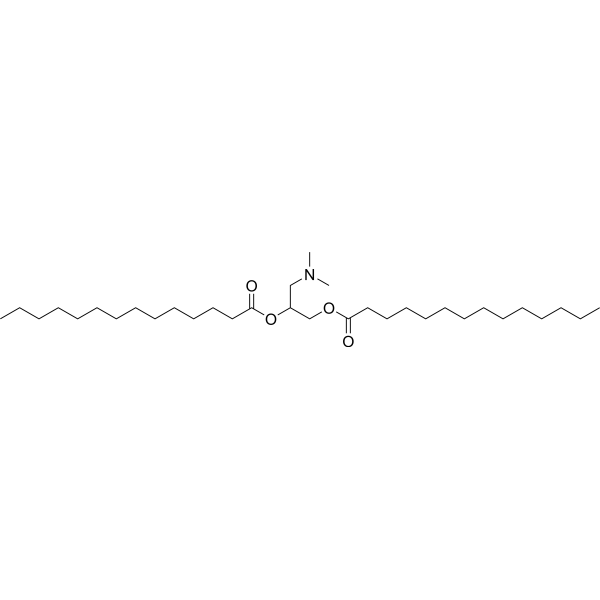
|
| DC71699 | DOIC |
DOIC is a cationic lipid that can be used for RNA vaccines.
More description
|

|
| DC71129 | Transfectam |
Transfectam is a cationic lipid able to interact with DNA to form complexes that mediate efficient gene transfer into various eukaryotic cells.
More description
|
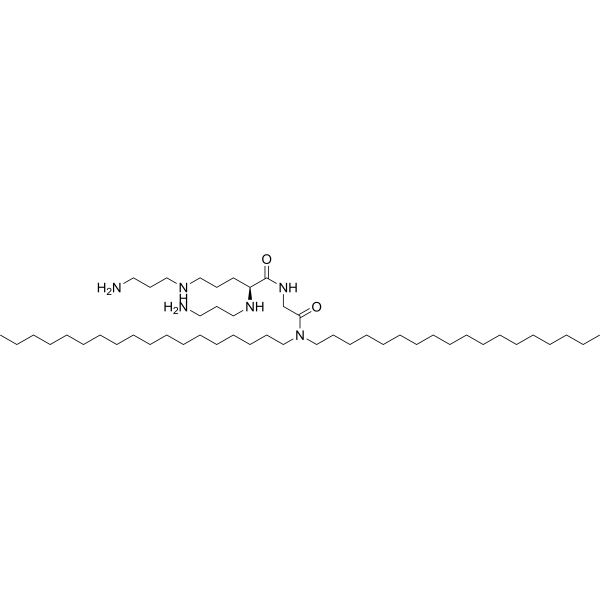
|
| DC71044 | Fluorescent DOTAP |
Fluorescent DOTAP, a cationic lipid, can be used for the research of nucleic acid and protein delivery.
More description
|

|
| DC80069 | OF-DEG-LIN |
OF-Deg-Lin is a biodegradable lipid containing an ester group, developed from the nonbiodegradable, linoleic acid derived OF-02; mRNA-LNPs containing OF-Deg-Lin showed high expression in the spleen. The ionizable lipid Of-Deg-Lin was synthesized,
which possessed the similar chemical structure with OF-02.Both Of-Deg-Lin and OF-02 had diketopiperazine core and
doubly unsaturated tails, and the difference between them
was that Of-02 contained nondegradable 1,2-amino-alcohol linkages,
whereas Of-Deg-Lin contained degradable ester linkages The change of linker altered iLNPs distribution
and mRNA expression in vivo. Although the Of-Deg-Lin iLNPs
could accumulate in the liver and spleen, they induced the
expression of most functional proteins in B lymphocytes of
spleen (over 85% of the total protein), not in the liver.
Of-Deg-Lin iLNPs can deliver mRNA and express functional
proteins in the spleen specifically, but the mechanism
is unclear.
More description
|
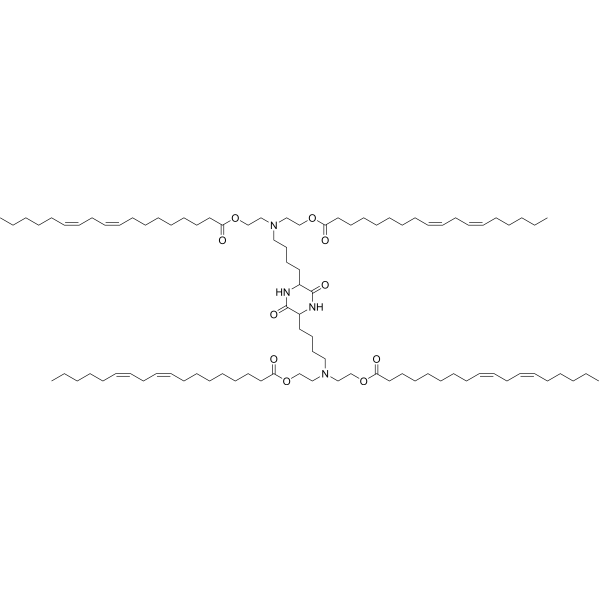
|
| DC80068 | LIPID PL1 |
PL1 is a novel biomimetic phospholipid. PL1 nanoparticle delivery of costimulatory
receptor CD137 mRNA improved the immunotherapy with an
anti-CD137 Ab to some extent in both tumor models with better
results obtained in the B16F10 melanoma model as compared to
the A20 lymphoma model.
More description
|
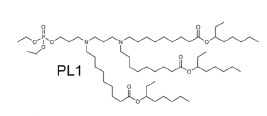
|
| DC81075 | CSL3 |
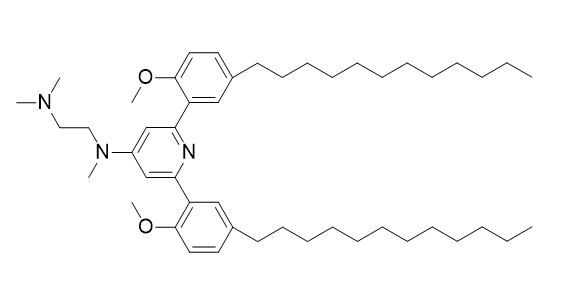
|